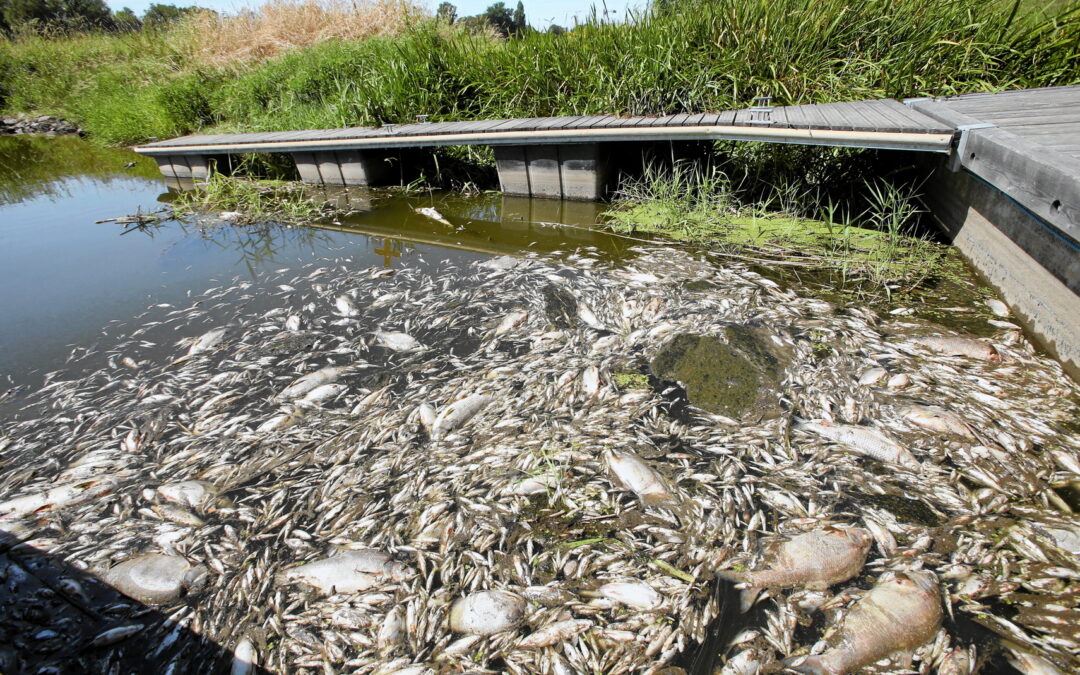By Wojciech Kość
The disaster on the Oder river this summer – which led to the death of 250 tonnes of fish – was a catastrophic yet natural occurrence. That, at least, is the official explanation from a group of scientists convened by Poland’s government, presented in a recent report.
The explanation is what environmental experts and activists had feared but expected all along: that the government would ultimately present the public with an impotent shrug rather than facing up to the longstanding failings – from various administrations – in managing Poland’s waterways that made the disaster possible.
By contrast, an official report from Germany – along whose border the Oder runs – published on the same day as the Polish one differed little in identifying the proximate causes of the disaster yet made clear that they were “human-made” rather than natural.
Poland's environment ministry yesterday announced that "many overlapping factors" contributed to the ecological disaster in the Oder river and that it "cannot yet answer all the questions".
It also found algal blooms to be a cause of mass fish die-offs https://t.co/lR2vNUhUIz
— Notes from Poland 🇵🇱 (@notesfrompoland) September 30, 2022
“After reading the [Polish] report I couldn’t help but feel like its focus was on the direct cause of the disaster but not the underlying one – which is systemic polluting of not just the Oder but most, if not all, inland waters in Poland,” says Sebastian Szklarek, an ecohydrologist at the Polish Academy of Sciences (PAN).
According to Szklarek and other experts, the report not only exposed the sorry state that the Oder has been in for many decades but also brought to light much wider failings.
“The disaster on the Oder revealed problems that have plagued water management in Poland for years: pollution, legal and organisational chaos, and treating the environment as the least important element in planning public budgets,” Szklarek wrote in an analysis of the government’s report.
The disaster and response
The observable chain of events that unfolded along the Oder from late July and throughout August is easy to rehash. Around 27 July, local anglers in the town of Oława observed dead fish in a lock on the Oder and linked their presence to earlier reports – from around mid-July – of similar sightings not far up the river, near the junction of the Oder and the Gliwice Canal, an artificial waterway linking the industrial region of Upper Silesia with the river.
Soon, reports of dead fish began flowing in from more locations down the river all the way to the so-called Lower Oder, a valuable nature reserve, and Szczecin, where the river empties into a local lake.
A map showing where thousands of dead fish have been found in the Oder river in Poland over the last two weeks, with suspicions that hazardous waste has entered the water.
It is a “catastrophe” that will have a wider impact on the environment, say experts https://t.co/BmW6Q29sJ7
— Notes from Poland 🇵🇱 (@notesfrompoland) August 11, 2022
After initial chaos of conflicting hypotheses as to what might have caused the disaster, analyses pointed to a golden algae bloom as a possible explanation of the fish die-off. The bloom itself was possibly a result of high concentration of saline water from industry or mining in the overall low level of the Oder water in July and August, due to excessive heat at the time.
The government, which had been under fire for a slow state response to the crisis, quickly latched onto the golden algae hypothesis with a narrative deflecting responsibility.
“[There are] more and more indications that the situation on the River Oder was a natural event [and that] there were no large discharges of chemical substances – not mercury or anything else that they tried to scare us with,” Prime Minister Mateusz Morawiecki said in late August.
“The Oder is regenerating fast,” he added.
The reports
The Polish report, compiled under the auspices of the Environmental Protection Institute (IOŚ), corroborated the early claims about algae toxins. “Water analysis showed no changes in its physical and chemical parameters that could explain such massive poisoning and death of the fish,” the report says.
Analysis did show – based on satellite images and sampling of chlorophyll and phytoplankton, as well as analysing “genes encoding pathways of toxin biosynthesis”, that the “immediate perpetrator of the ecological disaster on the Oder river was Prymnesium parvum”.
Prymnesium parvum is a type of alga capable of producing a toxin known as prymensin that is toxic to fish but apparently not harmful to humans.
The concurrently compiled German report arrived at the same conclusion, blaming the alga. But it strayed from the Polish conclusions by saying that the conditions in the river that made the algae bloom possible – primarily a spike in salinity – were “unnatural” and that the catastrophe was “human-made.”
Experts and activists agree that the golden algae bloom was just the tip of the iceberg of environmental neglect decades in the making. Legalised discharge of industrial wastewater is central to the problem, Szklarek says.
“Discharges, including the discharge of water from mining, are legal because the law gives the industrial polluters leeway,” he says, referring to the so-called water permits, which detail the parameters of wastewater that can be dumped to rivers.
The Polish report said that, at the time of compiling data, there were as many as 42 such permits along the Oder, covering discharge of “industrial or municipal wastewater containing chlorides and sulfates,” which are important drivers of water salination.
Diluted responsibility
But blaming just the salinity on the disaster is making a complex environmental problem too simplistic.
An opinion by the PAN advisory team on climate change, published before the ministry-commissioned report, said that while the direct cause of the disaster could have been the algae bloom, a number of other fundamental factors were also at play.
Other than the pollution, PAN experts said that longtime efforts to regulate the Oder and work to maintain infrastructure along the river, as well as climate-change induced heat that lowered the river’s water table, all facilitated the disaster.
While the Polish official report nodded to PAN’s assessment by saying that regulation – for example by slowing down water flows at weirs or in canals – is conducive to algae blooms, it did not dwell on the problem.
Regardless of the fundamental causes, the impact could have been smaller if there was sufficient monitoring, says hydrology professor Paweł Rowiński, a vice-president of PAN.
“The system of environmental monitoring is inadequate. We don’t have 24/7 monitoring points that provide non-stop data. We only had those data once the pollution reached Germany, which has this kind of monitoring,” says Rowiński.
The Polish environment ministry tacitly acknowledged this problem when, at the height of the Oder disaster in mid-August, they pledged 250 million zloty (€53 million) to build a new network of water quality monitoring stations.
The new “24-hour monitoring [system] with full online reporting” will ensure that data are sent quickly to environmental services from “key and critical locations along Polish rivers” so that they deploy people to any threatened location “within minutes”, the environment minister, Anna Moskwa, said at the time.
Rowiński is sceptical. “A lot will depend on institutions involved in the what and how of rolling out the new monitoring system. And speaking of institutions, the Oder case exposed just how fuzzy the responsibilities were,” he says.
Indeed, as local anglers raised the alarm about dead fish in the Oder, there came wildly contrasting reactions from the government in Warsaw and its regional representatives as well as from the state body that manages inland waters, Wody Polskie, and the environmental protection inspectorate, GIOŚ.
Morawiecki eventually dismissed the heads of Wody Polskie and GIOŚ, Przemysław Daca and Michał Mistrzak. But even in that move, the prime minister was wrong, says some critics. Mistrzak was one of the few officials to have reacted early by sending out warnings to regional inspectors already on 3 August.
Poland’s PM has fired the heads of the state water agency and environmental inspectorate, saying that the response to the contamination of the Oder river “could have been faster” https://t.co/USAAT7VmoD
— Notes from Poland 🇵🇱 (@notesfrompoland) August 12, 2022
But epitomising how complicated, and therefore ineffective, the system of environmental protection is in Poland, the regional inspectors – while being formally part of GIOŚ – are in fact officials reporting to provincial governors, who are government appointees and often politicians from Law and Justice (PiS), the main party in Poland’s ruling right-wing coalition.
Yet the dismissed head of GIOŚ, Mistrzak, was linked to United Poland (Solidarna Polska), a junior partner in the coalition that is seen as increasingly hostile to Morawiecki over a number of issues.
No system
The end result is that Poland was unprepared for what happened along the Oder and remains unprepared for similar disasters in future.
“Scientists have spoken about it for years, warning of the consequences until the consequences got real: you simply cannot treat rivers as waste dumps,” says Szklarek.
“Poland just does not have a working environmental protection system,” Robert Jurszo, a journalist covering climate and environment for the liberal newspaper Gazeta Wyborcza, which is often critical of the government, tells Notes from Poland on the phone from a field trip in the Lower Oder valley.
“The system is supposed to rest on GIOŚ and its regional branches, which are understaffed and underfunded. On the weekends, there literally is one official on duty per region in Poland. What we should have instead is an equivalent of the US Fish and Wildlife Service,” Jurszo says.
In August, a job offer by the Łódź branch of GIOŚ stirred controversy over pay conditions in Poland’s crucial environmental service. It sought an inspector for a gross monthly remuneration of 3,550 zloty (€721), which is 2,700 zloty net, barely over Poland’s minimum wage.
Protection versus regulation
An upside of the disaster is that it could finally lead to the beginning of a serious discussion about increasing protection of the Oder. And maybe other rivers.
There is already a national park covering the German part of the Lower Oder valley, and it is high time Poland followed suit, says Jurszo.
“It doesn’t have to be difficult, either, especially since Lasy Państwowe [the state forest agency] does not carry out timber harvesting in the area. It’s all wetlands,” he adds.
But the PiS government appears to have a different vision.
“Modernisation of the Oder via construction of weirs and a container terminal is our priority. No step back,” deputy infrastructure minister Marek Gróbarczyk said in late August in response to Germany’s calls on Poland to reconsider investment on the river.
The poisoning of the Oder could have been caused in Germany, which is now using the crisis to stop Poland from developing the river, says a Polish official.
Germany's environment minister recently called for Poland's redevelopment of the Oder to be haltedhttps://t.co/mJenDDsto9
— Notes from Poland 🇵🇱 (@notesfrompoland) August 30, 2022
Following the publication of the German and Polish reports, Germany’s environment minister Steffi Lemke said that Poland’s plans to economically develop the river “stand in the way of successful regeneration”. She had raised similar concerns on a visit to Warsaw in February, well before the outbreak of this summer’s crisis.
Experts and green activists have long said that the government’s idea of making the Oder – as well as the Vistula, Poland’s largest river – a cargo waterway is outdated and out of step with the challenges presented by the climate change and biodiversity crises.
“Sadly, experts aren’t part of the debate. It’s only journalists that reach out for opinion. I’m afraid that the Oder crisis will just pass without anyone learning from the mistakes that had led to it,” says Rowiński.
Main image credit: Cezary Aszkielowicz / Agencja Wyborcza.pl





















